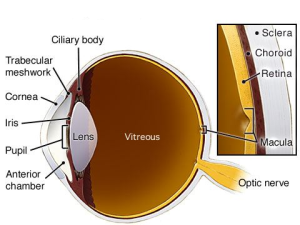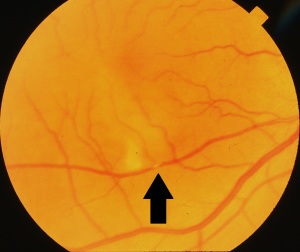As I’m sure you can imagine, as eye care professionals we get asked about eye dilation A LOT! Although patients are frequently aware that eye dilation is part of a comprehensive eye exam, they often use the side effects of dilation as a reason for not doing it – we’re all friends here, you can admit to this tactic.
This article will try to convince you of the importance of eye dilation by exploring what eye dilation actually is as well as how the benefits of this simple test can save eye sight. We will also dispel some eye dilation myths and misconceptions.
The Anatomy of Eye Dilation
The reason that eye dilation is even necessary is because of the anatomy of the human eye. Assessing the health of the front of the eye is a fairly easy task using our light microscopes; however, viewing the inside of the eye is a challenge. When light enters the eye through the pupil, there is a pretty nifty little neurological loop from your eyes to something called the Edinger-Westfall nucleus in your brain. This part of the brain links with the muscles of your iris to constantly control the size of the pupil and thus the amount of light allow ed into the eye. Being in dimmer environments makes the pupil open wider to let light in to improve vision, while being in brighter environments causes the pupil to constrict to decrease light sensitivity and glare. This is a great system for humans but a terrible system for eye doctors because the very bright lights from our microscopes makes the pupil so small we can’t see through it! It’s like trying to look through a keyhole into a room and reduces our view of the inside of the eye to only about 10-15%!! Going to an eye doctor and NOT getting your eyes dilated it like getting a physical but only letting your primary care doctor look at one leg.
ed into the eye. Being in dimmer environments makes the pupil open wider to let light in to improve vision, while being in brighter environments causes the pupil to constrict to decrease light sensitivity and glare. This is a great system for humans but a terrible system for eye doctors because the very bright lights from our microscopes makes the pupil so small we can’t see through it! It’s like trying to look through a keyhole into a room and reduces our view of the inside of the eye to only about 10-15%!! Going to an eye doctor and NOT getting your eyes dilated it like getting a physical but only letting your primary care doctor look at one leg.
Eye Dilation for Complete Eye and Systemic Health
In truth, eye dilation on adults is done to make sure ALL parts of your eyes are healthy and at Precision Family Eye Care, we would argue that eye dilation is the MOST important part of a comprehensive exam. By dilating the eyes we are able to see 100% of the interior of the eye and rule out all eye diseases: from Glaucoma and Macular Degeneration, to Cataracts and even eye tumors.
 The benefits of eye dilation don’t stop with the eye. The interior of the eye is unique in that is it the only place in the body where nerve tissue and blood vessels can be viewed without any advanced procedures or expensive testing. This allows your eye doctor a perfect opportunity to use the information gleaned from your dilated exam to identify problems and conditions elsewhere in the body. There are quite literally hundreds of systemic conditions (the short list) that can result in changes to the interior of the eye but some of the more common conditions are Diabetes and cardiovascular disease. The photo at right is a great example. This patient had no complaints, but a dilated exam found a cholesterol plaque in a retinal artery. This patient needs emergent care and testing due to a high stroke risk. At Precision Family Eye Care, we work closely with doctors from all specialties on cases like this to communicate eye health findings and improve care.
The benefits of eye dilation don’t stop with the eye. The interior of the eye is unique in that is it the only place in the body where nerve tissue and blood vessels can be viewed without any advanced procedures or expensive testing. This allows your eye doctor a perfect opportunity to use the information gleaned from your dilated exam to identify problems and conditions elsewhere in the body. There are quite literally hundreds of systemic conditions (the short list) that can result in changes to the interior of the eye but some of the more common conditions are Diabetes and cardiovascular disease. The photo at right is a great example. This patient had no complaints, but a dilated exam found a cholesterol plaque in a retinal artery. This patient needs emergent care and testing due to a high stroke risk. At Precision Family Eye Care, we work closely with doctors from all specialties on cases like this to communicate eye health findings and improve care.
Side Effects and Myths about Eye Dilation
First of all, it is important to note that there is NO substitute for dilation, although some offices may try to sell you alternatives. The newer digital systems these companies offer can take relatively good pictures of the retina. The problem is that these photos are only able to image about 65-70% of the retina and the 2-dimensional picture with poor resolution is not adequate to diagnose most eye diseases. Simply put, this technology does not reach the standard of care needed for a Comprehensive eye exam AND this testing is an additional fee whereas eye dilation is an included service with any visit.
With eye dilation, there are some temporary side effects. The most obvious side effect is light sensitivity because the larger pupils allow in more light. This is easily solved with sunglasses and temporary shades can be supplied by your eye doctor. Secondly, if you are under 50 years of age, the dilation drops also affect your ability to focus on up-close objects. These two side effects are temporary and only last 2-4 hours. Dilation will not affect your distance vision to the point where you will have trouble driving a car; a dedicated driver is an option but is certainly not a necessity.
How often should eyes be dilated?
Eye dilation is necessary at every visit for patients with certain systemic diseases like diabetes or in patients with confirmed eye disease. The vast majority of early staged eye diseases do not cause obvious symptoms (like blurry vision). Therefore it is necessary for patients to received routine dilation to rule out disease every couple years up to the age of 50 after which yearly dilated exams are strongly recommended.
Eye dilation definitely falls under the category of “necessary evil” but we hope that this discussion has convinced you of the importance of this procedure.
If it has been a few years since you have had your eyes dilated, we strongly recommend that you schedule a visit with an eye care professional.
See you next time on Eye to the Future and remember to take care of those eyeballs!
– Dr. Wolf


